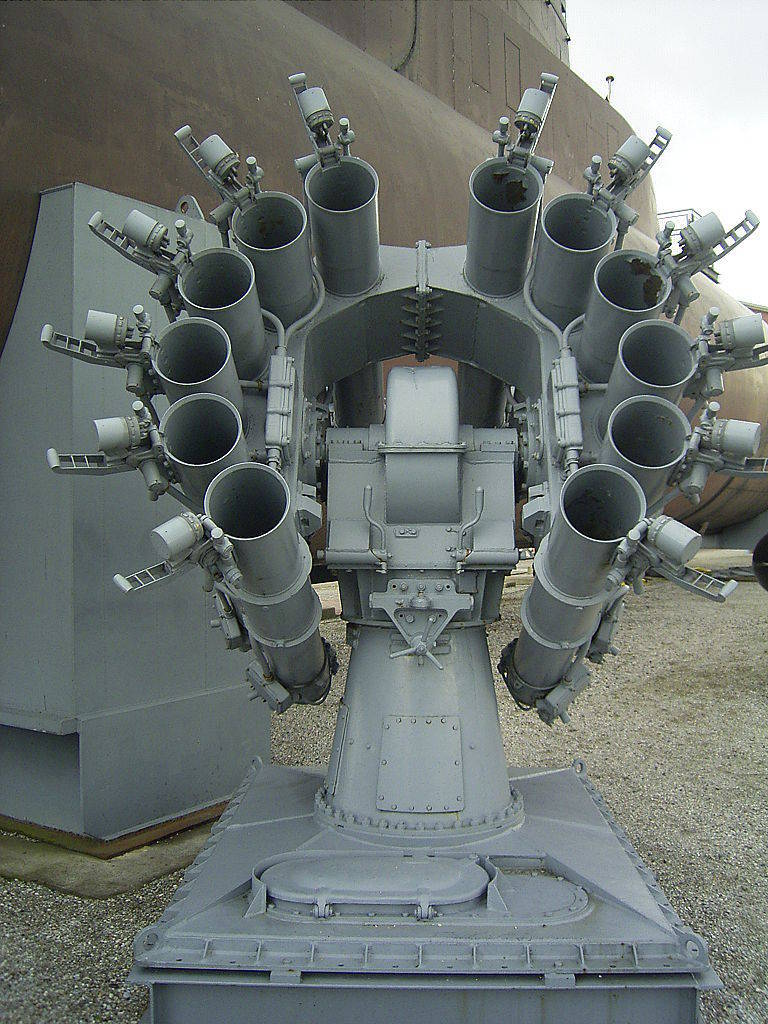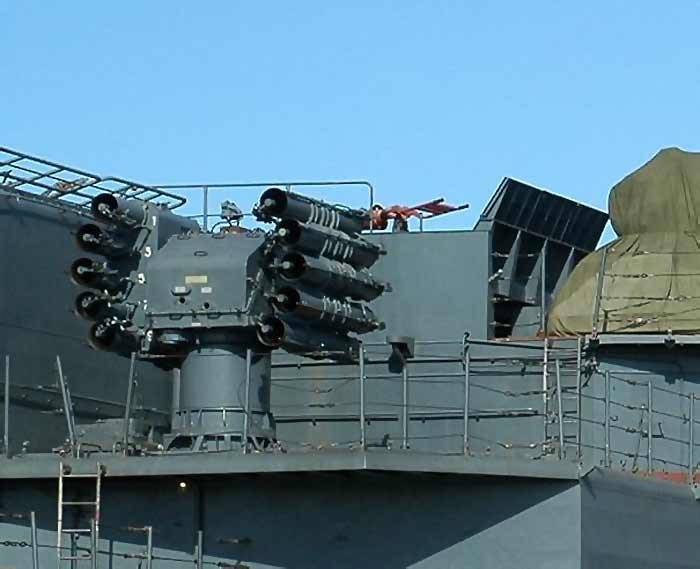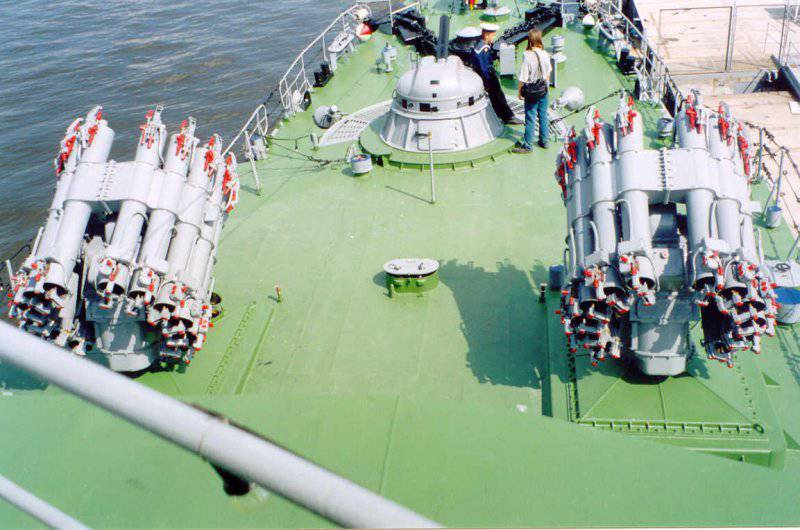Domestic anti-submarine bombers. Part II
Simultaneously with the bomb-gun RBU-2500, the staff of the Scientific Research Institute-1 under the direction of N.P. Mazurov worked on the anti-submarine system, designed to complement it. The new CURR-4500A “Burun” system was proposed to be installed at the stern of the ship. Her task was to shoot depth charges for the stern and re-attack the enemy submarine, already fired by the Smerch system. In this way, it was planned to increase the efficiency of anti-submarine systems, as well as to replace the long-obsolete fodder bombers.

The structure of the system "Burun" included four jet bombs RKU-36U. These units were a supporting platform with vertical guidance mechanisms, on which six shafts (two vertical rows of three shafts) of 302 mm caliber were attached. Shooting at the stern of the ship meant the loss of sonar contact with the enemy submarine. For this reason, the RKU-36U bomb bombs were suggested not to be equipped with horizontal guidance systems, but installed on the stern with a “fan”. In this case, it was possible to deliver a massive blow to a relatively large area.
"Finishing" the enemy submarine, damaged with the help of the bomb-bomb RBU-2500, was proposed with the help of the "jet-feed bombs" of the RSC. Each such ammunition with a weight of 180 kg carried 101 kg of explosive. The jet engine of the RKB bomb allowed to shoot at a distance of 90-115 meters. Once in the water, the bomb began to sink at speeds up to 11,4 m / s. The ammunition was equipped with a contact and contactless acoustic fuse WB-1M. Such equipment made it possible to destroy targets at depths up to 350. One volley of four bomb bombs of the RKU-4500A “Burun” system scattered depth charges on the site with dimensions of 120x200 meters.
To control the “Burun” system, the corresponding elements of the “Tornado” complex were used, as well as a set of special equipment “Tornado-56”. The latter, accepting information from the Smerch SSMP and ship systems, had to calculate the mutual position of the ship and the enemy submarine, as well as determine the moment of the shot.
High hopes were pinned on the Burun system, but it did not receive much distribution. Bombers of the RKU-36U were installed only on a few destroyers of the 56-PLO project. Instead of four aft bomb bombers, these ships received two each. Despite expectations like weapon considered ineffective: the attack of the submarine behind the stern implied a loss of contact with it, which could accordingly affect the accuracy of the shooting. During the next modernization, the bombers of the Burun system were replaced with RBU-2500.
RBU-6000 Smerch-2
The development of submarines and their weapons to the beginning of the sixties led to the fact that the ship had low chances to approach the enemy submarine at an attack distance. The submarine, in turn, could use torpedoes from a safe distance. Warships now needed weapons capable of fighting both enemy submarines and their torpedoes. The development of two similar systems at once was launched in accordance with the resolution of the USSR Council of Ministers on October 13 of 1960 of the year. The creation of new anti-submarine systems again engaged NII-1. The chief designer of the projects "Smerch-2" and "Smerch-3" became V.A. Mastalygin.

One of the main complaints about the previous anti-submarine bombers was manual preparation for firing. Seafarers had to manually enter the depth of the blast into the bomb detonators and put them on their own in the gun barrels. All this made it difficult to work, and also affected the rate of fire and the effectiveness of shooting. For this reason, the new jet bomber RBU-6000 anti-submarine system "Smerch-2" was the most automated. Almost all the complex operations associated with the preparation for the shooting, were assigned to various mechanisms.
Mechanisms of the bomb-missile RBU-6000 are located on the rotary stand installation. On its upper part there is a block of 12 mm 212 caliber barrels with a characteristic mutual arrangement. Stabilized installation allows you to direct trunks in any direction horizontally. Vertical pickup angles range from -15 ° to + 60 °. An important feature of the bomb-bomb RBU-6000 has become an automatic loading system. In preparation for firing, the block of trunks is brought to a vertical position (“elevation angle” 90 °), and a special system recharges them. The loader lift system consistently delivers depth charges from the cellar to the trunks. After the bomb is delivered to one of the barrels, the launcher turns and feeds the next barrel to the hatch. On the muzzle of all 12 trunks there is a folding mechanism with a connector for entering installations into a bomb fuze. Similar mechanisms are located on the breech breech and are responsible for the ignition of engines. The use of such systems allows minimizing human participation in the work of a bomb bomb. All processes of the complex operators are managed from their post.
The RBU-6000 bomb is designed for firing with RSL-60 jet depth bombs. Ammunition 1830 mm long and weighing 113 kg carries 23,5 kg of explosive. Depending on the angle of elevation of the barrels, shooting at a distance from 300 to 5800 m is possible. After being hit by water, the bomb sinks at a speed of up to 11,6 m / s. The RSL-60 bomb is equipped with a UDV-60 shock-and-distance fuse capable of initiating a charge detonation at depths of 15-350 meters. The depth of the blast is set using the remote control system. In the mid-sixties, a non-contact acoustic fuze WB-2 appeared, which was used simultaneously with UDV-60. Such equipment allows you to simultaneously explode all the bombs of a volley.
In addition to the bombing of the RBU-6000, the fire control system of the Temporary Storm Attachment Protection System with the Zummer prefix was included in the Smerch-2 anti-submarine system. It is possible to issue commands to the Purga anti-submarine defense control complex. The “Storm” system receives information on target homing from ship’s sonar tools and is capable of simultaneously controlling the operation of four RBU-6000 bombers. Depending on the situation, shooting by volley or single shots is possible. From the moment of detection of an enemy submarine to the first shot, no more than two minutes pass.
The RBU-6000 jet bomb and other components of the Smerch-2 system were put into service in 1961. The new anti-submarine system was very successful, due to which it was widely used in the Soviet and then the Russian naval navy. RBU-6000 bombs were installed on several dozen cruisers, destroyers, large anti-submarine ships, watchdogs, etc. various types. Some of these ships still serve as part of the Russian Navy.
In the late eighties, the RBU-6000 bombayer received a new ammunition - a rocket depth bomb (rocket) 90P. Rocket caliber 212 mm and length 1832 mm has a starting weight at the level of 112,5 kg. The ammunition warhead is equipped with an 19,5 kg explosive. By the principle of operation, the 90P product does not differ from the standard jet bomb of the RBU-6000 system. In this case, the rocket has several advantages over RSL-60. The response time of the anti-submarine system was reduced to 15 seconds, the maximum firing range was 4300 m. The minimum firing distance was 600 m. When attacking submarines, the 90P rocket can work at depths up to 1000 m. equipment received the designation RPK-6000 "West".
RBU-1000 Smerch-3
In parallel with the RBU-6000 bombometer, a similar system was developed by the RBU-1000 "Smerch-3". This bomb was in general similar to the previous one, but had a number of important differences that determined its characteristics. At the same time, both bomb-bombs had some common components and assemblies, and also used general operating principles, which allowed the staff of SRI-1 to simplify their development and construction.
The overall appearance of the RBU-1000 bomb bomb was borrowed from the RBU-6000 project. A block of six barrels of caliber 300 mm was mounted on a stabilized swivel stand with mounting mechanisms. The trunks were divided into two blocks of three, mounted to the right and left of the main mechanisms. The unification of some of the mechanisms affected the angles of guidance: the RBU-1000 bombers could fire in any direction (except for sectors covered by the ship's structure) with an elevation from -15 ° to + 60 °. Under the bomb, in the under-deck room, located automation, responsible for reloading barrels. The principle of operation of the automation was similar to RBU-6000. There was an automatic system for introducing installations into bomb detonators.
For use with the RBU-1000 bomber, the RSL-10 jet depth bomb was developed. Ammunition length 1800 mm weighed 97 kg. The streamlined bomb could sink at speeds up to 11,8 m / s. The shock-remote fuse UDV-60 allowed to use the bomb at depths up to 350. The solid propellant jet engine sent the RSL-10 bomb to the distance from 100 to 1000 meters. A six-shot volley lasted about 3 seconds.
The unification of the two bombombets touched not only certain elements of the structure, but also control systems. The determination of the required guidance angles and the timing of the shot were assigned to the “Storm” control system with the “Buzzer” prefix. As in the case of the RBU-6000 bombometer, the reaction time did not exceed 1-2 minutes. PUSB "Burya" received target designation from the ship's sonar system.
The bomb of the RBU-1000 system "Smerch-3" was adopted in 1961 year. Two bombs of this model (in some cases in combination with a pair of RBU-6000) were installed on the cruisers of the 1134 project, BOD Ave. 1134-A and 1134-B, as well as on the patrol and destroyers of several projects.
RBU-12000 Udav (RKPTZ-1 Udav-1)
With the advent of new submarines with higher characteristics, surface ships have lost the ability to destroy them with existing bomb-bombs. Now such weapons could only be used to fight torpedoes. In this regard, the latest at the moment the domestic bomb-gun RBU-12000 was developed as a system of anti-torpedo protection, which was reflected in its alternative designation RKPTZ-1 (“Reactive anti-torpedo defense complex, the first”). The project RBU-12000 / RKPTZ-1 was created in the Kolomna design bureau of mechanical engineering.

The basis of the ECPTZ-1 system is the KT-153 launcher. Its design is largely reminiscent of previous domestic bomb-equipped bombs with an automatic loading system: a block of ten 300 mm caliber barrels located on sectors of a circle were mounted on the main boom set. Launcher mechanisms allow you to direct trunks in a wide range of angles. For reloading, the barrel unit takes up a vertical position and rotates around its axis before serving the next ammunition. For supplying ammunition, the 111UPM device is included in the anti-torpedo protection complex.
The RKPTZ-1 Udav-1 complex uses two types of ammunition. To counter the self-guided torpedoes designed rocket projectile 111CO. The projectile serves as a false sonar target and “distracts” the self-guided torpedoes from the ship. The 111SZ projectile barrage is equipped with a high-explosive warhead and performs the functions of a minefield. The task of the 111SZ projectile is to destroy a torpedo while passing at a short distance from it. The third ammunition - deep projectile 111SG. According to the principle of action, it is similar to other jet depth charges. All ammunition complex "Boa-1" have a length of 2,2 meter. The weight of the projectile payload is about 200 kg. The 111SZ and 111SG projectiles are heavier — up to 220-230 kg and carry about 80 kg of explosive. The firing range of all types of shells - 100-3000 m. The maximum depth of destruction of deep ammunition - 600 m.
The use of three types of missiles in combination with the new control equipment made it possible to create a new algorithm for the operation of the complex. Bombers of previous models delivered a massive blow to the submarine's area of location. The change of purpose (the fight against torpedoes) and the emergence of new ammunition led to the emergence of other methods of work.
According to reports, when an enemy's torpedo is detected, the EKPTZ-1 system shoots two firing projectiles at maximum range. These ammunition should bring a torpedo at itself and prevent it from attacking the ship. When a torpedo breaks through the "first echelon" of anti-torpedo protection, shells-barriers come into play. With the help of these munitions created a minefield in the way of a torpedo. If the torpedo passed and the shells-barriers, the complex opens fire with 111SG depth bombs. One volley of shells of three types allows you to destroy a direct-falling torpedo with probability 0,9. The probability of hitting the torpedoes homing - 0,76.
The anti-torpedo protection complex RKPTZ-1 "Udav-1" was put into service in December 1986 of the year. This system is equipped with an aircraft-carrying cruiser “Admiral of the Fleet of the Soviet Union Kuznetsov” of the 1143.5 project (2 launchers); heavy nuclear missile cruisers "Admiral Nakhimov", "Admiral Lazarev" and "Peter the Great" Ave. 1144.2 (one PU); as well as the BOD "Admiral Chabanenko" pr. 1155.1 (two PU). The ships “Admiral of the Fleet of the Soviet Union Kuznetsov”, “Peter the Great” and “Admiral Chabanenko” are currently serving in the Russian Navy.
The upgraded version of the complex called RKPTZ-1М Udav-1M retained the basic elements of the basic system, but received new ammunition. To simplify the supply and operation of the complex, only two rocket projectiles were used: the 111CO2 projectile and the 111SZG protective projectile. Product 111СЗГ can serve as a barrier and deep projectile and carries 80 kg of explosive.
***
In the late sixties, the missile anti-submarine complex RPK-1 "Whirlwind" was adopted. To defeat enemy submarines, this complex used an unguided rocket with a special warhead. The maximum firing range reached 24 kilometers, which was several times longer than the range of bomb bomb that existed at that time. In the future, Soviet designers have created several anti-submarine missile systems. Such systems allowed attacking enemy submarines at a distance of several tens of kilometers. For example, the 83PH rocket of the RPK-6 Vodopad-NK complex could fly to a range of 37 km and deliver the UGMT-1 torpedo to the target. The warhead of the 54PH rocket of the same complex was the nuclear depth bomb.
Anti-submarine missile systems have become quite widespread, but so far they have not been able to completely displace the rocket bomb bombers. Both bomb and rocket complexes are still used on the ships of the Russian Navy. The composition of anti-submarine weapons depends on the tasks assigned to the ship. For example, the aircraft-carrying cruiser “Admiral of the Soviet Navy” is equipped with two launchers of the RKPTZ-1 / RBU-12000, and the BOD “Admiral Chabanenko” carries both Vodopad missiles and the Udav-1 system. There is reason to believe that the Russian Navy ships will retain the latest-generation jet bomb bombs as part of their weapons. In addition, systems like the Udav-1M complex can also be used on advanced ships.
Based on:
http://flot.sevastopol.info/
http://vadimvswar.narod.ru/
http://otvaga2004.ru/
http://wunderwafe.ru/
http://ship.bsu.by/
http://rbase.new-factoria.ru/
http://militaryrussia.ru/blog/topic-128.html
Shirokorad A.B. Weapons of the domestic fleet. 1945-2000. - Minsk: “Harvest”, 2001

Information